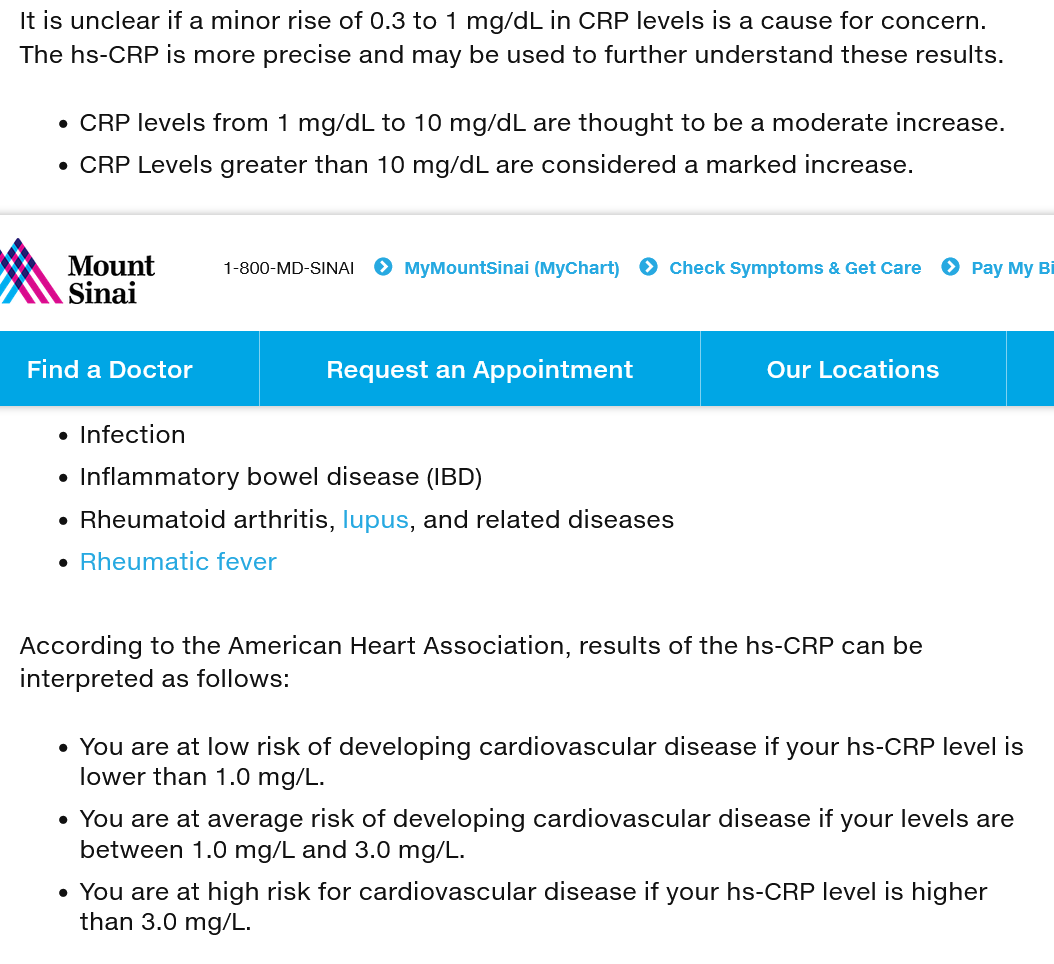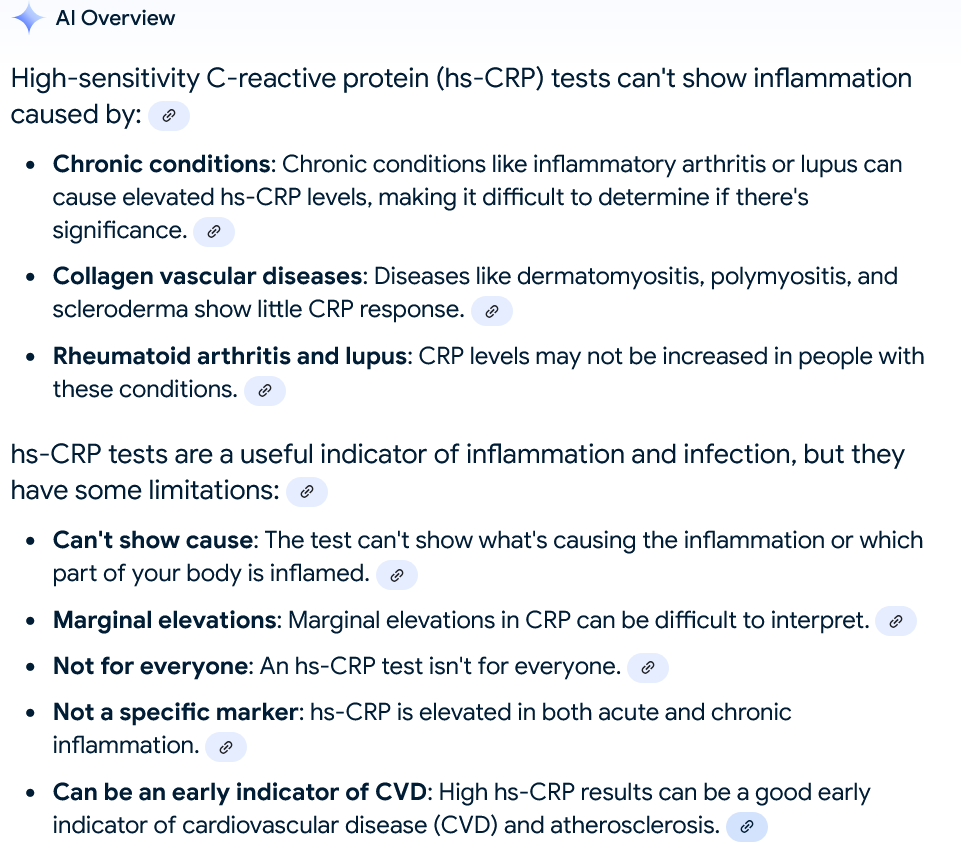This is great information and some of their products dovetail with Life Extension. Thank you!
Another test you might want to add is Myeloperoxidase (MPO) that measures disease activity from the luminal aspect of the arterial wall. MPO is actively involved in the progression of atherosclerosis
FWIW…
And
“The Role of Myeloperoxidase in Biomolecule Modification, Chronic Inflammation, and Disease”
https://www.liebertpub.com/doi/full/10.1089/ars.2020.8030
A quick AI-generated search.
Please verify critical facts.
Myeloperoxidase Blood Test
The Myeloperoxidase (MPO) blood test measures the level of myeloperoxidase, an enzyme produced by white blood cells, in the blood. MPO plays a crucial role in killing bacteria and other microorganisms. Elevated MPO levels are often associated with inflammation or infection in the body.
Uses
Evaluation of inflammation and infection: The MPO test helps diagnose and monitor conditions characterized by excessive inflammation or infection, such as:
Leukemia and lymphoma
Vasculitis (inflammation of blood vessels)
Microscopic polyangiitis (MPA)
Monitoring disease progression and treatment response: The test can aid in tracking disease activity and response to therapy in patients with conditions like MPA.
Procedure
The MPO blood test is a simple procedure:
A small sample of blood is drawn from a vein in your arm.
The blood is sent to a laboratory for analysis.
Key Points
MPO levels are typically higher when there is inflammation or infection in the body.
The test can help identify individuals at risk for increased plaque formation on their arteries.
In conjunction with other autoantibody tests (ANCA, PR3), the MPO test may aid in evaluating suspected immune-mediated vasculitis.
Note: This information is based on the provided search results and aims to provide a concise and accurate overview of the Myeloperoxidase blood test
AI-generated search.
Please verify critical facts.
@DrFraser @Dr.Bart How concerned are you with low fibrinogen? Mine tested at 164 mg/dL recently, which is outside of the LabCorp range (193-507).
ChatGPT suggests that low fibrinogen can indicate lower inflammatory status, as well as reduced risk of pathological clot formation. However, it also suggests that low fibrinogen can slow wound healing and lead to increased bleeding. It may also indicate underlying conditions like liver disease, disseminated intravascular coagulation, and genetic fibrinogen deficiencies.
It’s a good question. At the moment I just get HsCRP and it’s very low (.03-.07). But I’m interested in the best testing. Especially for measuring the benefits of something like taking rapamycin which often doesn’t seem to show any changes in blood markers or even the latest epigenetic BioAge clocks. So I’m on the lookout for tests that would consistently show a benefit of weekly (or?) rapamycin or metformin or SLGT2 or tadalafil or any intervention that is done for longevity and might not show an immediate effect. Even something like reducing arterial plaque thickness (if possible) would be a slow process that might take years but it would improve circulation and therefor both healthspan and lifespan. And it’s measurable.
Inflammation besides being a hallmark of aging (Inflammaging) is also a marker of atherosclerosis so I believe that if your inflammation markers are very low, you aren’t actively building plaque. How effectively do the different inflammation markers measure endothelial inflammation? Lp-PLA2 seems to be a specific marker.
Lp-PLA2 is a 50-kDa, Ca2±independent enzyme associated with LDL. Small dense LDL particles are very atherogenic and readily undergo oxidative modification (117). The enzyme is a subtype of a growing family of A2 phospholipases and is secreted mainly by macrophages, monocytes, mast cells, and T lymphocytes. The enzyme has proinflammatory properties because it hydrolyzes oxidized phospholipids to lysophosphatidylcholine and free oxidized fatty acids and thus is the enzyme responsible for most of the increased lysophosphatidylcholine content of OxLDL particles. The atherogenic potential of OxLDL has been attributed to this high lysophosphatidylcholine content. Several prospective epidemiological studies have reported that Lp-PLA2 is a predictor of CAD (117), although controversy persists as to its independence from LDL cholesterol. The relationship of Lp-PLA2 to LDL cholesterol is also supported by several studies showing equivalent decreases in Lp-PLA2 and LDL cholesterol levels in response to several different classes of lipid-lowering agents (118). Further, in contrast to the situation for CRP, the levels of which are reduced by statin therapy in a manner independent of the effects on LDL cholesterol, there is little evidence that statins lower Lp-PLA2 levels once LDL cholesterol level reduction is accounted for.
https://jnm.snmjournals.org/content/48/11/1800#sec-22
What I’m most interested in is the different mechanisms of the inflammation markers. Il-6 and HsCRP seem to correlate closely, but I’d be interested in when they diverge.
From google AI:
- IL-6 release
When inflammation is triggered, IL-6 is released into the bloodstream by neutrophils, macrophages, and other cells at the site of damage or infection.
- CRP production
IL-6 stimulates the liver to produce CRP and other acute phase proteins, which are then released into the bloodstream.
- CRP levels
As IL-6 levels rise, so do CRP levels. In severe infections or burns, CRP levels can increase from less than 1 μg/mL to up to 1000 μg/mL.
IL-6 and CRP are both markers of systemic vascular inflammation. They have been independently associated with cardiovascular events and mortality in both healthy men and women.
GlycA also is connected to atherosclerosis. Here from Marek Dianostics -(price is reasonable)
Enhanced Lipid Panel (Lipid Panel, ApoB, GlycA, DRI)
Price Regular price $50
GlycAis a novel composite marker of inflammation that reflects enzymatic glycosylation, the process by which sugar attaches to proteins. GlycA reflects the serum concentration and glycosylation state of five major acute-phase inflammatory proteins (a1‐acid glycoprotein, haptoglobin, a1‐antitrypsin, a1‐antichymotrypsin, and transferrin).
The big question is what are these other markers telling you that HsCRP isn’t? and how is it actionable? Certainly a direct head to head comparison of all these markers would be useful. I’ll continue to investigate - Like when would IL-6 tell you more than HsCRP?
Also interesting in terms of endothelial health/dysfunction is this thread on the glycocalyx.
https://www.rapamycin.news/t/glycocalyx-does-it-completely-absorb-damage-from-glucose-spikes-up-to-an-extent-does-endocalyx-work-for-regenerating-it-ways-to-measure-its-health/7769?u=ng0rge
Both the EndoPAT and the GlycoCheck tests look good. Circulation affects everything.
Dysfunctional endothelium is characterized by vasoconstriction, increased vascular permeability, thrombosis, and inflammation. This pathological state is often associated with elevated levels of biomarkers such as prothrombin time, D-dimer, von Willebrand factor, fibrin degradation products, C-reactive protein (CRP), ferritin, Interleukin 6 (IL-6), and plasma creatinine. The result of this endothelial dysregulation is a cascade of adverse effects, including vasoconstriction, vascular leakage, thrombosis, hyperinflammation, and a disrupted antiviral immune response. These changes contribute to the progression of vascular diseases.
A non-invasive, FDA-approved device for measuring endothelial function that works by measuring Reactive Hyperemia Index (RHI) is Itamar Medical’s EndoPAT.[19][20] It has shown an 80% sensitivity and 86% specificity to diagnose coronary artery disease when compared against the gold standard, acetylcholine angiogram.[21] This results suggests that this peripheral test reflects the physiology of the coronary endothelium.
I’d consider a low fibrinogen to be a good thing, indicating low level of inflammation, so long as the HsCRP was also low. This is inducible - when you need it, you can pump it out quickly within 24-48 hours. I’d rather have a low than normal level myself.
I would check the units on your CRP.
An aside @ng0rge but I am fascinated by your CRP readings. The standard level of precision for hsCRP is in the range of 0.01 to 0.1 mg/L, depending on the assay used and a value of 0.50 falls in the lowest decile for a male your age. Assuming no error, do you know what you are doing to achieve this level, probably in the lowest 0.1% of the distribution? What is your IL-6 score? Congratulations are in order. I do a lot to lower my inflammation markers and have been very happy with values in the 0.25 area.
I have not encountered a lab that can measure below 0.15mg/l. Sometimes labs report in mg/dl, however.
I do not have enough personal data to know but I was able to learn that the lower limits of precision range from 0.01 (presumably that is +/- 0.01) all the way up to 0.1, depending on the lab and method. I would think that most modern labs are achieving 0.01. Scientific convention suggests that labs should either not report scores to the hundredth or there should be an asterisk, especially at the lower end of the range.
A correction to what I stated above. For a 70 year old male:
- 0.5 mg/L would place an individual in the lowest 25% of the distribution.
- 0.25 mg/L would place an individual in the lowest 10%.
These figures are approximate and extrapolated from:
- Median hsCRP: Around 1.5–2.0 mg/L.
- Interquartile range: Typically spans from 0.5 mg/L to 3.0 mg/L.
I’m not certain of the quality of this data but it seems plausible other than the median for a 70 year old man being a bit lower than I would have expected.
Yes, John, we covered this in another thread. And when I looked, I saw the difference in units - mg/dL vs mg/L - so my low HsCRP (.05 mg/dL) isn’t low compared to yours. I assumed it was a difference in units between Europe and the US, but now I’m not sure. A google search said this:
" AI Overview
Learn more…
High-sensitivity C-reactive protein (hs-CRP) is usually reported in milligrams per deciliter (mg/dL)."
And gave this link:
https://www.ncbi.nlm.nih.gov/books/NBK441843/
Lab values vary, and there is no standard at present. However, in general, the result is reported in either mg/dL or mg/L. Hs-CRP is usually reported in mg/dL.
But I also saw this…where it switches almost mid-sentence without explanation.
What I’m most interested in, is what the different inflammation markers - HsCRP, IL-6, fibrinogen, TNF-a, MPO, ESR, GlycA, Lp-PLA2 have that is unique to that one marker and won’t be shown by the other markers. For example, if I have low HsCRP (by whatever units), do I need to worry that I may have inflammation that HsCRP is not picking up? OK, I know, google is my friend…
It’s a difference in units.
I would be interested in your source of data for a 70 year old male.
Yes
John, with your very low HsCRP score, what other inflammation markers do you check with your blood tests, and what do they tell you that HsCRP doesn’t?
I see that TNF-a costs $94 USD at Marek and IL-6 costs $75 USD at Life Extension ($185 USD at Marek), so what do they tell you that HsCRP doesn’t?
ESR seems the cheapest and certainly with the home tester unit shown above, the easiest. But it also looks less sensitive.
It was an interpolation @John_Hemming based on NHANES (including Ford’s article based on it: Ford et al., 2003, "C-Reactive Protein Concentration Distribution Among US Adults), Framingham, Health ABC, CHS, and Rotterdam. I have been interested in CRP as a potentially highly leveraged health metric. These numbers seem reasonable although the variance between them is not a small as I would like to see it.
As I said above my HsCRP in mg/L would be .5 mg/L (sorry for the confusion on units), so…
While that seems good, it could be better. I guess it means I have some inflammation.
I’m exploring this subject more as I believe that inflammation, blood sugar, senescent cells and circulatory health - as well as epigenetics - are the critical factors in longevity.
Again, what do you think IL-6 or TNF-a tells you, that is actionable, if your HsCRP is low?
I focus on CRP. I dont add to the panel that much, but ferritin is interesting.

